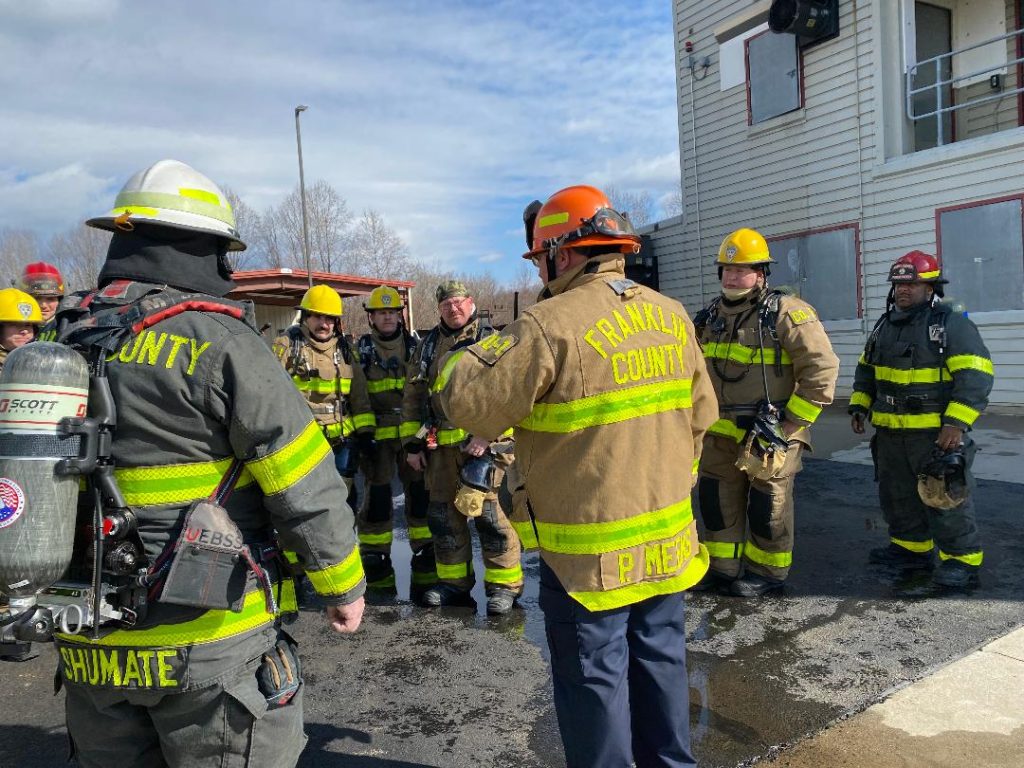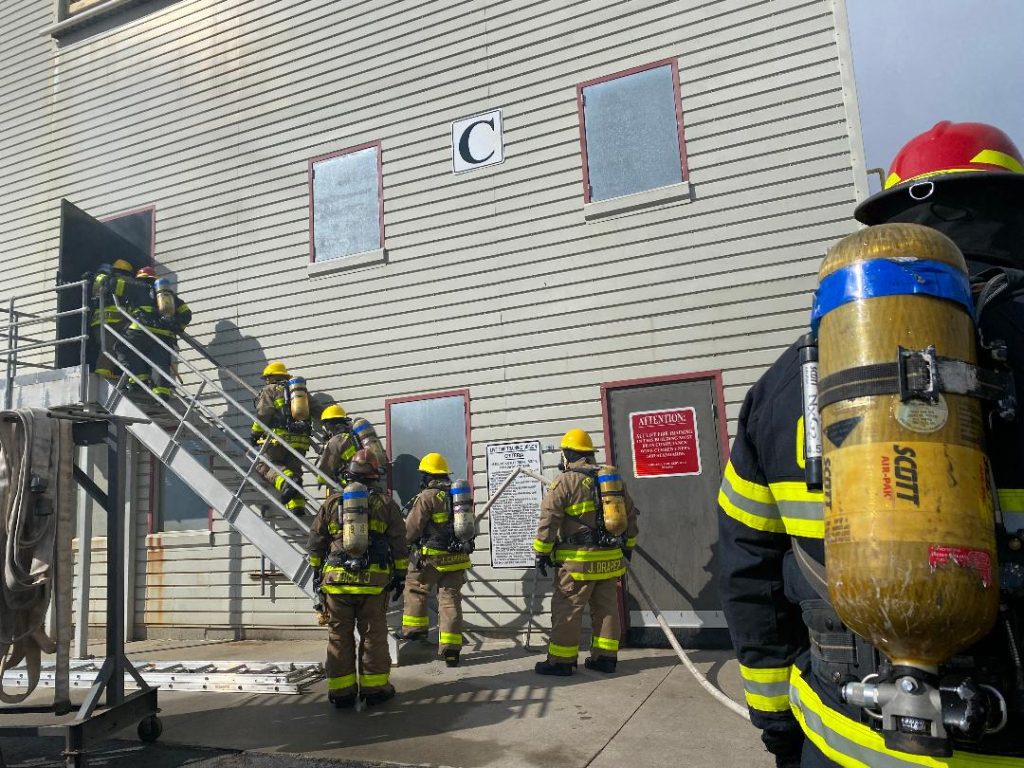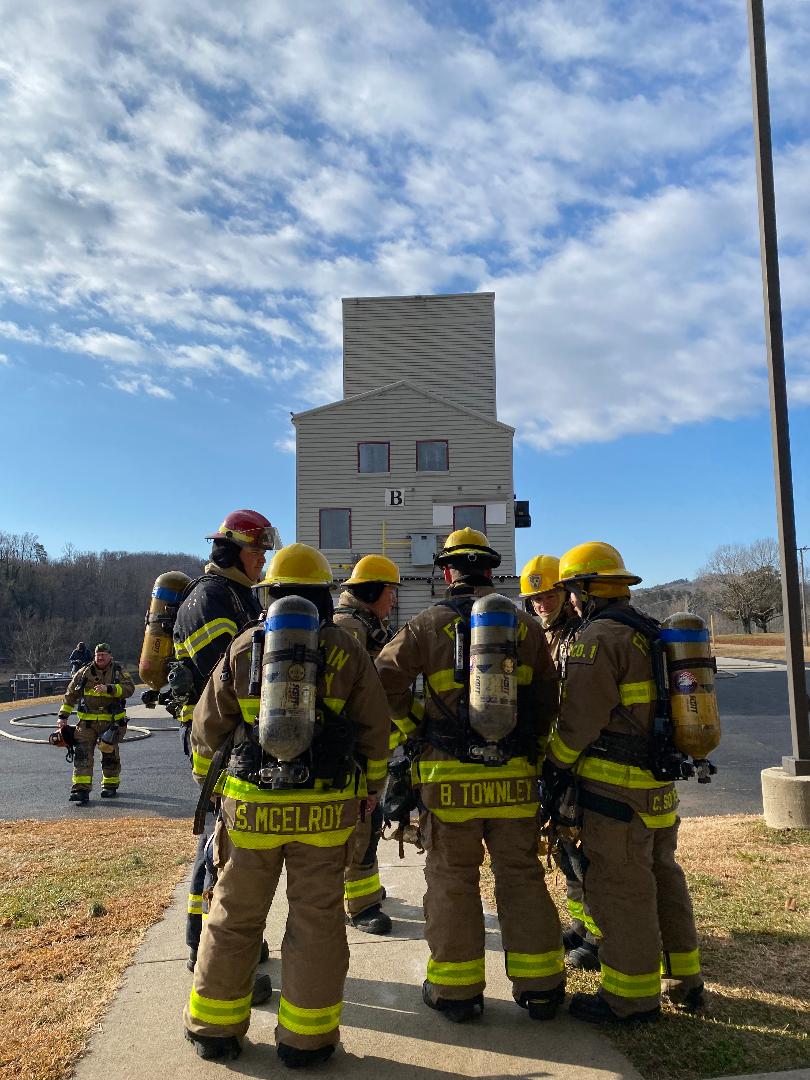
By Callie Hietala
One by one, students in the first class of the Blue Ridge Fire & EMS Academy filed into a burning building, hoses and tools in hand, battling first one blaze, then another and another, to complete the live burn portion of their Firefighter 1 state test.
The fires were artificially created in a building constructed to withstand the flames. The Henry County Burn Building Facility was constructed to train firefighters for a number of scenarios in a relatively safe environment. It was dedicated in 2004 and built with funds from the Harvest Foundation, Virginia Fire Services Board, and the Virginia Department of Fire Programs.
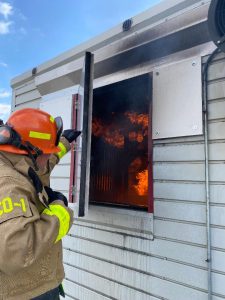
Propane lines in the building kept the flames burning and temperature sensors in the structure could be used to shut everything down in an instant if the situation got out of control. Exhaust fans helped remove smoke and steam from the interior.
Instructors were both inside the building and around it, watching with the practiced eyes that years of experience provides, as firefighting students set up ladders, fed hoses into the building, and worked together to safely extinguish the fires, honing the skills that are essential to their new career path.
“This is the first time we’ve ever done a career academy,” Henry County Director of Public Safety Matt Tatum said. “We’ve done firefighter training before, done EMT training before for many, many years,” but the training has always been for volunteers.
This group of students, he said, are training from 8 a.m. until 4 p.m., Monday through Friday, to gain the skills, pass the tests, and earn all the certifications necessary to become a full-time firefighter/EMTs.
The academy was created due to staffing shortages that are being felt across the nation.
“We were just so short-staffed,” said Tatum.
Previously, he said, “Henry County was blessed with a tremendous amount of very good, qualified volunteer firefighter/EMTs and so we hired from that pool. Now, we’re to the point that the people who do it as a volunteer don’t want to do it as a career,” meaning the county had difficulty finding applicants who were already trained. The solution was to find new recruits and train them, hence the creation of the academy.
Tatum likened the strategy to that of joining the police force — “you don’t hire a volunteer police officer that’s already trained, you hire someone that wants to be a police officer, you train them, and then you put them in the field.
“They will come out (of the academy) being well-trained entry-level firefighter/EMTs,” Tatum said, adding that there will be many opportunities for the students to advance even further in their training. He hopes many will pursue the two-year associate degree program offered through Patrick & Henry Community College. The education is necessary to become a qualified paramedic which, he said, “is the highest level of medical pre-hospital level care training you can get.”
Though details are not yet confirmed, Tatum said the county plans to advance many of the students through its Firefighter 2 program.
This first academy, he said, began in November and is being conducted in partnership with Franklin County. He said officials approached Martinsville, Patrick County, Pittsylvania County, and Danville to invite them to participate as well, but none did.
Only two Henry County trainees were part of Monday morning’s group. The rest of the nine-member class were from Franklin County. Tatum said five recruits from Henry County began the class, but two dropped out early in the program, quickly realizing the job was not for them. A third, who Tatum described as one of the best in the class and a star pupil, had to move out of the area due to a family issue.
One of the two remaining Henry County recruits, Kevin Perkins of Martinsville, said he chose this new career path (he previously worked at a call center) to serve his community and to be a positive influence for future generations.
The training, Perkins said, is “not what I expected. It’s a lot more strenuous, but that’s great because it’s preparing us for the real world.”
Tatum acknowledged the job was a physically demanding one — he said a study was completed some time ago that concluded that 20-minutes of active firefighting equated to eight hours of manual labor in a standard industry.
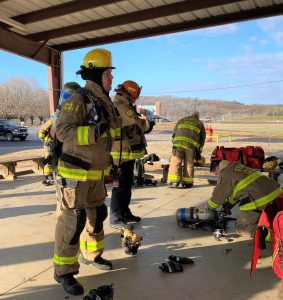
He said that the air pack itself, which a firefighter carries on their back, weighs around 20 pounds. In addition, firefighters must be strong enough to lift and carry both equipment and people.
Some academic ability, too, is necessary for success in the field, Tatum said. “You have to be able to take tests, you have to be able to remember things and apply things, be critical thinkers,” he said.
Flexibility is yet another quality Tatum looks for in a firefighter. “There’s no such thing as a Monday through Friday, 8 to 5 firefighter,” he said, explaining fire crews could be called on weekdays and weekends, early mornings and late nights, in good weather and bad, and must be ready to answer the call.
Essential, too, is compassion. Tatum quoted Teddy Roosevelt, who is credited with saying, “Nobody cares what you know until they know that you care.
“What we are looking for is the individual who truly cares about the other person,” Tatum said. Compassion and trustworthiness are both critical. Tatum said applicants also must have a clean criminal history.
“When you’re on calls, many times you’re dealing with people in their most vulnerable state, and when you come into those homes, you’re put into a position of trust that the checkbook that’s on the kitchen table will still be on the table when you leave,” he said.
All of these qualities — physical and mental ability, compassion, trustworthiness — are critical in a profession in which “many times, your decisions truly are life and death,” Tatum said.
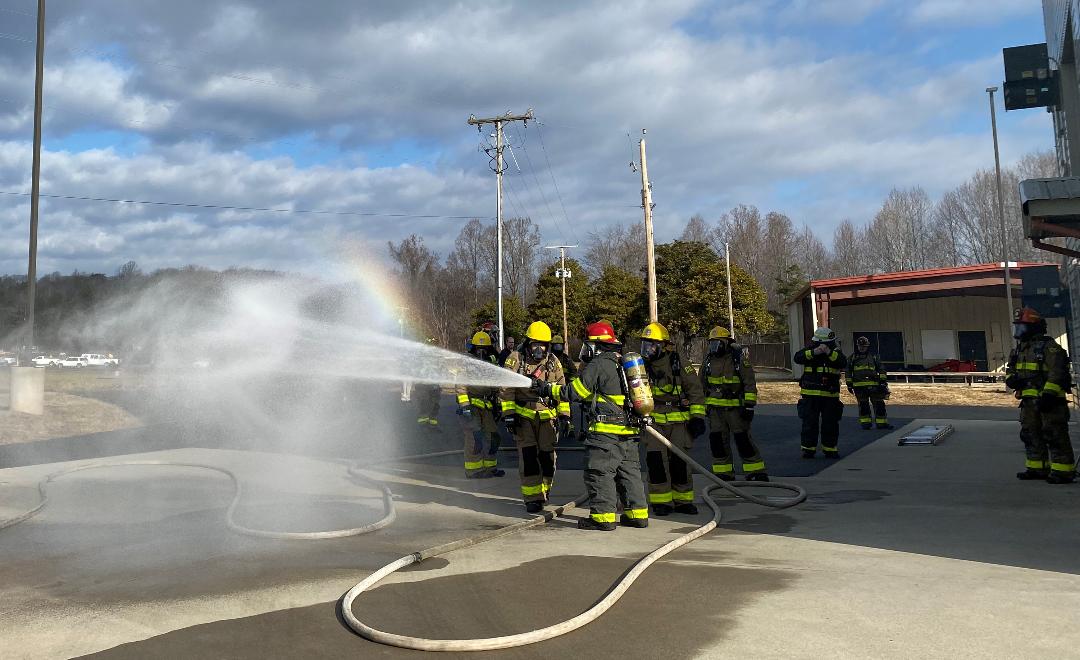
The morning was dappled with reminders of the life-and-death job these recruits were training to do. Often, when students were listening to instructors’ directions or critiques, a sharp, loud beeping would break through the silence. A slight shake or wiggle would quiet the device.
This was the sound of the PASS (Personal Alert Safety System) alerts worn by each student and firefighters on the job. The devices, Assistant Chief of Training Kenny Shumate said, are designed to go beep when a firefighter is motionless for more than 20 seconds, alerting others that one of their colleagues could be in danger.
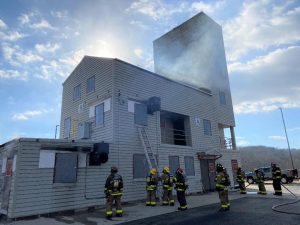
One group of students works together to get a ladder in place as heavy smoke billowed from the second story of the burn building.
Tatum said the recruit pay for the Henry County trainees was a little more than $12 per hour, or about $25,500 annually. Once the students graduate and go into the field (this first class, which began in November 2022 will graduate within the week), their pay automatically increases to an estimated $33,000 per year.
Tatum said applications are now being accepted for the next academy, which is set to begin May 2. Franklin County has already committed to joining again, he said. While he does not anticipate recruits from Martinsville, Danville, or Pittsylvania County, Tatum said he has not yet heard back from Patrick County to gauge its interest in participating.
Overall, he and the instructors agreed the initial graduating class has done well.
In addition to the live burn testing completed that day, trainees must pass a 100-question state test and a skills test, during which eight skills are randomly selected that the 28 the recruits must master, Shumate said.
He seemed confident that the students of this first career academy would do well in meeting the challenges to come.
“They’re ready,” he said.
Anyone wishing to apply for the next Blue Ridge Fire & EMS Academy may visit http://www.henrycountyva.gov/jobs.



